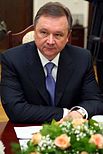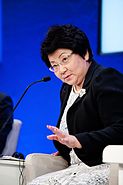Kyrgyzstani parliamentary election, 2007
|
|
||||||||||||||||||||||
|---|---|---|---|---|---|---|---|---|---|---|---|---|---|---|---|---|---|---|---|---|---|---|
|
||||||||||||||||||||||
|
All 90 seats to the Supreme Council of Kyrgyzstan |
||||||||||||||||||||||
|
||||||||||||||||||||||
|
||||||||||||||||||||||
Iskenderbek Aidaraliyev
Independent
Early parliamentary elections were held in Kyrgyzstan on 16 December 2007. The election was called by President Kurmanbek Bakiyev after the constitutional referendum on 21 October 2007 approved a new electoral system and constitutional reform proposals, enlarging the parliament to 90 MPs and introducing party-list voting.
Twenty-two parties filed to run in the election, but some reconsidered and six were rejected by the authorities, including Taza Koom ("Clean Society"). Thus the following parties contested the election:
On 28 November 2007, Prime Minister Almazbek Atambayev from the Social Democratic Party resigned and Iskenderbek Aidaraliyev became Acting Prime Minister until the election; the resignation was reportedly over differences between Atayev and Bakiyev.
To enter parliament, a party had to pass two thresholds:
According to preliminary results based on 81% of the polling stations, turnout was over 60%, but no party apart from Ak-Zhol had managed to pass both thresholds. Ak-Zhol reportedly received 47.8% of the vote. Ata-Menken received 9.3% of the vote nationwide, but failed the regional thresholds in three regions. Ak-Zhol therefore appeared to be the only party to enter parliament. International monitors from the Organization for Security and Co-operation in Europe heavily criticised the election. Monitors from the Commonwealth of independent States, however, claimed the election met democratic standards. Later results showed that two other parties, the Social Democratic Party and the Communist Party, narrowly managed to pass the national threshold.
...
Wikipedia


